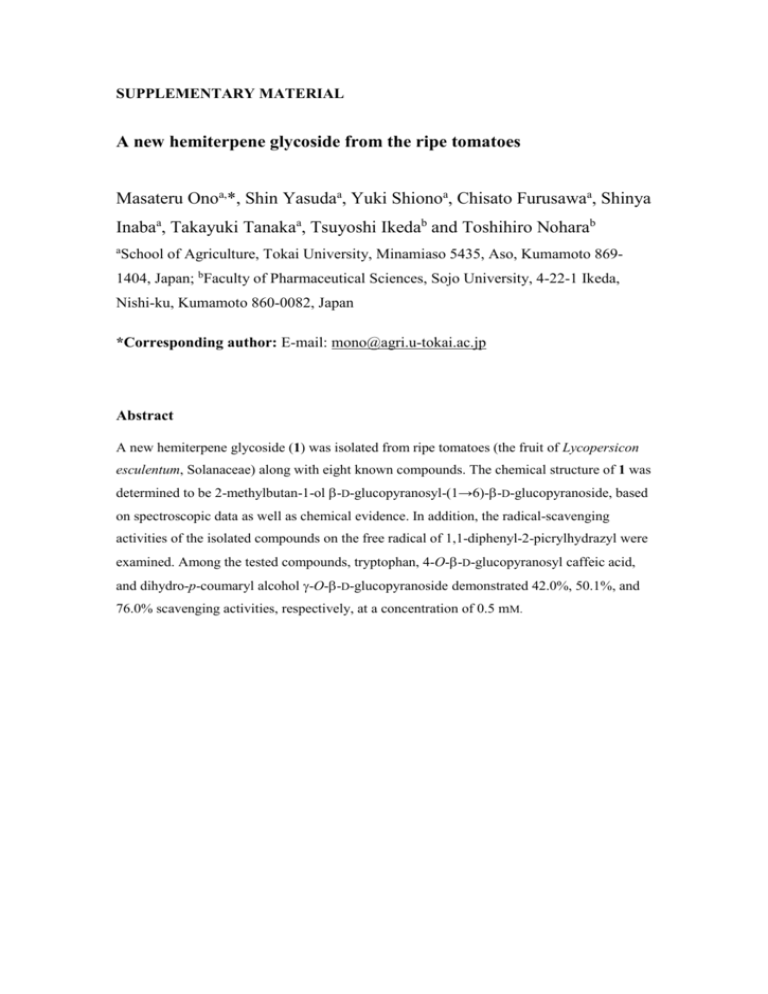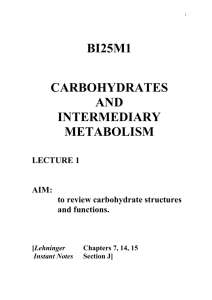GNPL_Supplementary Material_Template_Word_XP_2007
advertisement

SUPPLEMENTARY MATERIAL A new hemiterpene glycoside from the ripe tomatoes Masateru Onoa,*, Shin Yasudaa, Yuki Shionoa, Chisato Furusawaa, Shinya Inabaa, Takayuki Tanakaa, Tsuyoshi Ikedab and Toshihiro Noharab a School of Agriculture, Tokai University, Minamiaso 5435, Aso, Kumamoto 869- 1404, Japan; bFaculty of Pharmaceutical Sciences, Sojo University, 4-22-1 Ikeda, Nishi-ku, Kumamoto 860-0082, Japan *Corresponding author: E-mail: mono@agri.u-tokai.ac.jp Abstract A new hemiterpene glycoside (1) was isolated from ripe tomatoes (the fruit of Lycopersicon esculentum, Solanaceae) along with eight known compounds. The chemical structure of 1 was determined to be 2-methylbutan-1-ol -D-glucopyranosyl-(1→6)--D-glucopyranoside, based on spectroscopic data as well as chemical evidence. In addition, the radical-scavenging activities of the isolated compounds on the free radical of 1,1-diphenyl-2-picrylhydrazyl were examined. Among the tested compounds, tryptophan, 4-O--D-glucopyranosyl caffeic acid, and dihydro-p-coumaryl alcohol -O--D-glucopyranoside demonstrated 42.0%, 50.1%, and 76.0% scavenging activities, respectively, at a concentration of 0.5 mM. Table S1. 1H- and 13C-NMR spectral data for 1 (in pyridine-d5) H Agl-1a Agl-1b Agl-2 Agl-3a Agl-3b Agl-4 Agl-5 Glc-1 Glc-2 Glc-3 Glc-4 Glc-5 Glc-6a Glc-6b Glc'-1 Glc'-2 Glc'-3 Glc'-4 Glc'-5 Glc'-6a Glc'-6b * 4.08 3.99 dd(6.5, 9.5) 1.72 m 1.51 m 1.11 m 0.80 t(7.5) 0.94 d(7.0) 4.76 d(8.0) 4.00 dd(8.0, 8.5) 4.21 dd(8.5, 8.5) 4.16 dd(8.5, 8.5) 4.11 m 4.87 dd(1.5, 11.5) 4.36 dd(6.5, 11.5) 5.15 d(7.5) 4.06* 4.26* ca. 4.27 3.95 m 4.54 dd(1.5, 12.0) 4.39 dd(4.5, 12.0) C 75.0 35.4 26.4 11.4 16.8 104.9 75.1 78.5 71.8 77.3 70.2 105.5 75.3 78.5 71.7 78.5 62.8 in ppm from TMS (coupling constants (J) in Hz are given in parentheses). Agl, aglycone moiety. Glc, inner glucosyl group. Glc', terminal glucosyl group. *, Signals were overlapping. 1H-NMR spectral data (500 MHz). 13C-NMR spectral data (125 MHz). Table S2. 1H- and 13C-NMR spectral data for 8 (in pyridine-d5) H Agl-1a Agl-1b Agl-2a Agl-2b Agl-3 Agl-4a Agl-4b Agl-5 Agl-6a Agl-6b Agl-7a Agl-7b Agl-8 Agl-9 Agl-10 Agl-11a Agl-11b Agl-12a Agl-12b Agl-13 Agl-14 Agl-15a Agl-15b Agl-16 Agl-17 Agl-18 Agl-19 Agl-20 Agl-21 Agl-22 C 1.48* 0.79* 2.06 m 1.61* 3.94* 1.81* 1.40* 0.90* 1.14* 1.09* 1.50* 0.81* 1.27* 0.51 ddd(2.5, 8.5, 8.5) 1.37* 1.11* 1.65* 1.00 m 37.2 29.8 78.7 34.8 44.6 28.8 32.3 34.9 54.5 35.8 20.7 38.2 41.8 0.92 54.5 2.17 ddd(6.5, 7.5, 14.0) 33.2 1.39* 4.99 ddd(4.5, 7.5, 7.5) 82.7 1.84 br d(7.5) 59.0 0.70 s 13.8 0.62 s 12.2 2.70 q(7.5) 36.3 1.31 d(7.5) 17.9 181.1 * H Gal-1 Gal-2 Gal-3 Gal-4 Gal-5 Gal-6a Gal-6b Glc-1 Glc-2 Glc-3 Glc-4 Glc-5 Glc-6a Glc-6b Glc'-1 Glc'-2 Glc'-3 Glc'-4 Glc'-5 Glc'-6a Glc'-6b Xyl-1 Xyl-2 Xyl-3 Xyl-4 Xyl-5a Xyl-5b 4.90 d(7.5) 4.41 dd(7.5, 9.5) 4.18* 4.61 d(3.5) 4.05* 4.64 dd(8.5, 11.0) 4.23* 5.15 d(8.0) 4.34 dd(8.0, 8.5) 4.11 dd(8.5, 8.5) 3.78 dd(8.5, 8.5) 3.85* 4.49 dd(1.5, 10.0) 4.03* 5.54 d(7.5) 4.07 dd(7.5, 8.5) 4.09* 4.17* 3.93* 4.52 dd(1.5, 10.5) 4.37* 5.19 d(8.0) 3.95 dd(8.0, 8.5) 4.18* 4.12* 4.23* 3.68 dd (10.5, 10.5) C 102.4 73.2 75.4 79.9 75.6 60.6 105.1 81.3 86.8 70.5 77.3 63.0 104.8 76.2 77.6 71.1 77.8 62.5 104.9 75.1 78.6 70.7 67.3 in ppm from TMS (coupling constants (J) in Hz are given in parentheses). Agl, aglycone moiety. Gal, galactosyl group. Glc, inner glucosyl group. Glc', terminal glucosyl group. Xyl, Xylosyl group. *, Signals were overlapping. 1H-NMR spectral data (500 MHz). 13C-NMR spectral data (125 MHz). Figure S1. Connectivities elucidated by the 1H-1H COSY spectrum (bold lines) and 1 H-13C long-range correlations (arrows) observed in the HMBC spectrum of 1 (in pyridine-d5, 500 MHz) Trolox 3 4 6 0 20 40 60 80 100 Scavenging Effect (%) Figure S2. DPPH radical-scavenging effects of 3, 4, 6, and Trolox. Data shown represent mean ± S.D. derived from four determinations. The final concentration of each sample tested was 0.5 mM. Figure S3. 1H-NMR spectrum of 1 (in pyridine-d5, 500 MHz) Figure S4. 13C-NMR spectrum of 1 (in pyridine-d5, 125 MHz) Figure S5. 1H-1H COSY spectrum of 1 (in pyridine-d5, 500 MHz) Figure S6. HMQC spectrum of 1 (in pyridine-d5, 500 MHz) Figure S7. HMBC spectrum of 1 (in pyridine-d5, 500 MHz) Figure S8. Positive FAB-MS of 1 Figure S9. Positive FAB-MS of 1 Figure S10. 1H-NMR spectrum of 8 (in pyridine-d5, 500 MHz) Figure S11. 13C-NMR spectrum of 8 (in pyridine-d5, 125 MHz) Figure S12. 1H-1H COSY spectrum of 8 (in pyridine-d5, 500 MHz) Figure S13. HMQC spectrum of 8 (in pyridine-d5, 500 MHz) Figure S14. HMBC spectrum of 8 (in pyridine-d5, 500 MHz)









